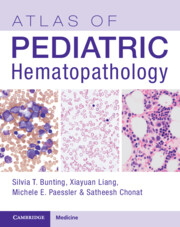Book contents
- Atlas of Pediatric Hematopathology
- Atlas of Pediatric Hematopathology
- Copyright page
- Contents
- Contributors
- Section I Peripheral Blood
- Section II Normal and Non-neoplastic Hematolymphoid Diseases
- Section III Mature Lymphoid Neoplasm
- Section IV Precursor Hematopoietic Neoplasms and Related Neoplasms
- Chapter 13 Precursor Lymphoblastic Leukemia/Lymphoma
- Chapter 14 Blastic Plasmacytoid Dendritic Cell Neoplasm
- Chapter 15 Acute Myeloid Leukemia and Related Precursor Neoplasms
- Chapter 16 Myeloproliferative Neoplasms
- Chapter 17 Myelodysplastic/Myeloproliferative Neoplasms
- Chapter 18 Childhood Myelodysplastic Syndrome
- Chapter 19 Germline Predisposition to Myeloid Neoplasia
- Chapter 20 Germline Predisposition to Lymphoid Neoplasm
- Chapter 21 Mastocytosis and Myeloid Lymphoid Neoplasms with Eosinophilia
- Section V Histiocytic Neoplasm and Miscellaneous Bone Marrow Diseases
- Index
- References
Chapter 14 - Blastic Plasmacytoid Dendritic Cell Neoplasm
from Section IV - Precursor Hematopoietic Neoplasms and Related Neoplasms
Published online by Cambridge University Press: 25 November 2023
- Atlas of Pediatric Hematopathology
- Atlas of Pediatric Hematopathology
- Copyright page
- Contents
- Contributors
- Section I Peripheral Blood
- Section II Normal and Non-neoplastic Hematolymphoid Diseases
- Section III Mature Lymphoid Neoplasm
- Section IV Precursor Hematopoietic Neoplasms and Related Neoplasms
- Chapter 13 Precursor Lymphoblastic Leukemia/Lymphoma
- Chapter 14 Blastic Plasmacytoid Dendritic Cell Neoplasm
- Chapter 15 Acute Myeloid Leukemia and Related Precursor Neoplasms
- Chapter 16 Myeloproliferative Neoplasms
- Chapter 17 Myelodysplastic/Myeloproliferative Neoplasms
- Chapter 18 Childhood Myelodysplastic Syndrome
- Chapter 19 Germline Predisposition to Myeloid Neoplasia
- Chapter 20 Germline Predisposition to Lymphoid Neoplasm
- Chapter 21 Mastocytosis and Myeloid Lymphoid Neoplasms with Eosinophilia
- Section V Histiocytic Neoplasm and Miscellaneous Bone Marrow Diseases
- Index
- References
Summary
Blastic plasmacytoid dendritic cell neoplasm (BPDCN) is a rare, aggressive malignancy that is notable for frequently presenting with skin lesions and for its unfavorable prognosis. The revised fourth edition of the World Health Organization classification places BPDCN in a separate, stand-alone chapter between acute myeloid leukemia and acute leukemias of ambiguous lineage in recognition of its distinct lineage and aggressive clinical behavior. [1]. Knowledge of the cell of origin and the increasing availability of markers specific for plasmacytoid dendritic cells has recently allowed the recognition of heterogeneity in the clinical presentation and immunophenotype of BPDCN [2].
- Type
- Chapter
- Information
- Atlas of Pediatric Hematopathology , pp. 140 - 146Publisher: Cambridge University PressPrint publication year: 2023



